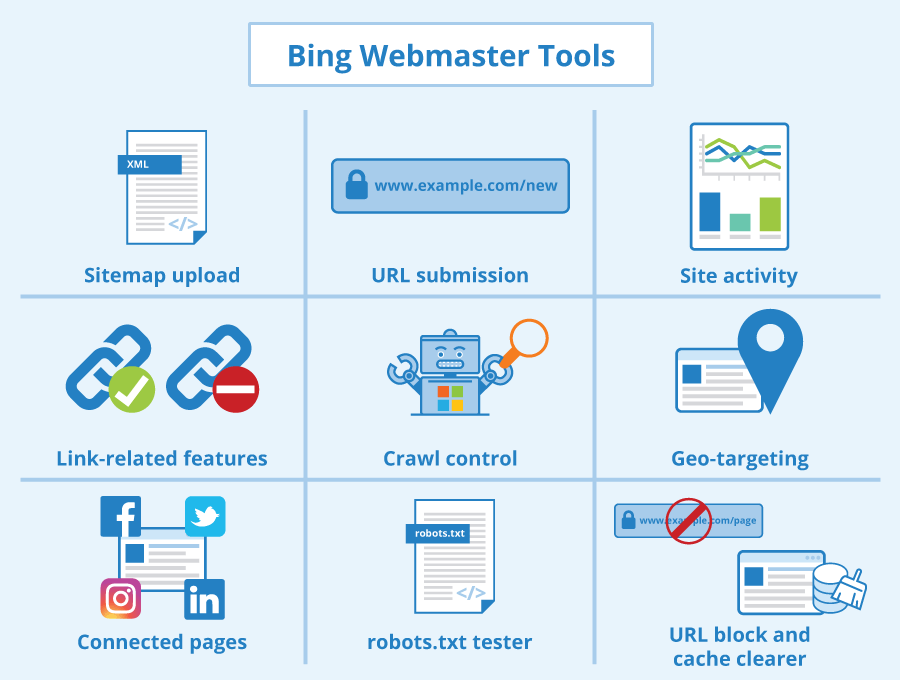Backlink Analysis in Bing Webmaster Tools
Bing Webmaster Tools (BWT) provides a comprehensive suite for analyzing your website’s backlink profile directly from the Bing search index. This tool is especially valuable for SEO professionals focusing on Bing’s search ecosystem, as it offers data not always available through third-party platforms.
Key Features of Bing’s Backlink Tool
- Backlink Inventory: View all backlinks pointing to your site, organized by referring domains, pages, and anchor texts.
- Export Capabilities: Download your entire backlink profile as a
.csvfile for further analysis. - Competitor Comparison: Compare your backlink profile side-by-side with competitors to identify link-building opportunities.
- Disavow Tool: Submit lists of low-quality or spammy backlinks you want Bing to ignore when evaluating your site.
- Filtering: The tool is designed to automatically filter out spammy-looking backlinks, focusing your analysis on higher-quality links.
Link Quality Insights in Bing Webmaster Tools
Bing’s Approach to Link Quality
Bing places significant emphasis on the quality and relevance of backlinks, with some notable differences from Google’s approach:
- Domain Authority: Bing tends to reward links from historically reliable, authoritative domains—especially those with a long online presence.
- Semantic Relevance: The relevance of the linking page’s content to your site’s content is a strong ranking signal.
- Anchor Text: Bing uses anchor text rigorously to understand context; a natural, balanced distribution of anchor texts is favored over keyword stuffing.
- Directory and Institutional Links: Links from reputable directories, government, academic, or industry-specific sites are viewed positively.
- Nofollow Links: Unlike Google, Bing may consider some nofollow links as useful signals for relevance, though they do not directly pass link equity.
How to Interpret Backlink Data for SEO
- Quantity vs. Quality: While the number of backlinks and referring domains is important, Bing’s algorithm is more selective about link quality than in the past.
- Diversity: A diverse backlink profile from multiple domains and types of sites is beneficial.
- Toxic Links: Use the disavow tool to mitigate the impact of harmful or spammy links.
- Competitive Analysis: Regularly compare your backlink profile with competitors to uncover gaps and opportunities.
Practical Steps for Backlink Analysis in Bing Webmaster Tools
- Log in to Bing Webmaster Tools and verify your site.
- Navigate to the Backlinks section to view your link profile by domain, page, and anchor text.
- Export your data for deeper analysis or reporting.
- Compare with competitors using the “Similar sites” feature to benchmark your off-page performance.
- Identify and disavow toxic links to protect your site’s reputation.
- Monitor trends over time to assess the impact of your link-building efforts.
Summary Table: Bing vs. Google Backlink Evaluation
| Aspect | Bing Webmaster Tools | Google Search Console |
|---|---|---|
| Data Source | Direct from Bing index | Direct from Google index |
| Competitor Comparison | Built-in feature | Not available |
| Nofollow Links | May be considered for relevance | Generally ignored for ranking |
| Anchor Text | Highly emphasized, natural distribution favored | Important, but less strict |
| Disavow Tool | Available | Available |
| Export Options | Full CSV export | Limited export options |
Conclusion
Bing Webmaster Tools offers robust, first-party backlink analysis capabilities, with a strong focus on link quality, relevance, and competitive benchmarking. By leveraging these insights, SEO professionals can refine their link-building strategies to better align with Bing’s ranking factors, ultimately improving organic visibility in Bing search results.



